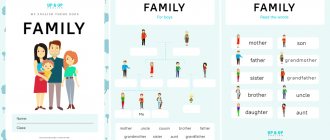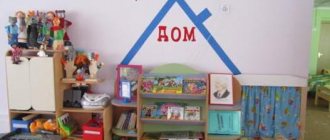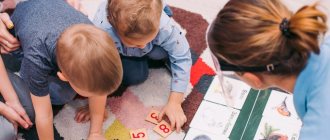Every modern parent understands that children need knowledge of a foreign language, and they must come to school with the basic knowledge they already have. Therefore, at the peak of popularity, English for children is in a playful form, which allows you to explain important information in an accessible way for preschoolers, as well as have fun with them.
Best age
Some parents believe that it is not at all necessary to study English at home, since the child will receive all the necessary knowledge and skills at school. But this is not so, a modern first-grader should already have some information, otherwise he will have a very difficult time. On the one hand, get used to a new main type of activity - learning, giving up the usual game. On the other hand, remember huge flows of information on all subjects.
To avoid such a burden, you should start training in a timely manner. The first fun activities can be carried out at 3 years old, but without trying to pass on to the child everything that the parent knows - learning several groups of words is quite enough.
At 3-4 years old, a child has the following qualities that will help him in learning:
- the ability to remember a huge flow of information;
- interest in understanding the world, curiosity;
- lack of embarrassment in pronouncing foreign words, which will appear over time;
- the ability to imitate speakers well in the peculiarities of their pronunciation.
Classes become more serious by the age of 5 - at this time intensive preparation for school is carried out, so parents should think in advance what educational games and exercises they will use.
Senior group. Senior preschool age. Children 5-6 years old
Subject development environment for English in the senior group
Creation of an English language environment in a preschool group . Childhood is a stage of preparation for a child’s future life, which is unique and of great importance in his development. The period from birth to entry into school is, according to experts around the world, the age of the most...
Lesson for children of senior preschool age “Journey along the English rainbow, colors” Lesson in English on the topic “Colors”
(
"Colors"
)
"Magic rainbow" "Magic Rainbow"
Senior
preschool age (6-7 years old. Group "BUNNY"
: 14 people. Teacher: Anna Aleksandrovna Boeva Goal: repetition and systematization of knowledge on the topic
"Colors"
. Tasks: • automate…
Study Rules
In order for home English lessons to become desired and loved, it is important to make sure that they are interesting to the child. Parents need to follow several recommendations.
- Only a game form - there should be no boring cramming and strict discipline in classes.
- Using a variety of games and tasks.
- Appeal to didactic material.
- An excellent motivator is praise, so you should definitely rejoice at your child’s successes, but scolding and anger from parents can forever destroy the desire for new knowledge - that’s why you shouldn’t do this. The child tried, so you can at least praise him for that.
- Coercion is also unacceptable. If the baby does not feel well or is capricious, then it is better to postpone the lesson for a more appropriate time.
- Work according to the principle “from simple to complex”. At first, it will be enough to tell the child the name of some flowers in English, and during a walk ask him to find everything that is “red.” Gradually, home lessons will become more and more difficult.
The most important thing in the learning process is to use the child’s natural desire to explore the world at this age and give him material useful for his future life in an easy, unobtrusive form.
Types of games
All games are divided into 2 large categories: individual and group. The second type is most often used in kindergartens and special courses; at home, together with the parents, the child will be happy to play an individual game. Among them, you can choose those that are really interesting to a particular child. These can be outdoor games, fun with elements of drawing and singing, or competitions. The main thing is that the baby has fun and interesting, only in this case he will study with pleasure.
Here are examples of individual games for preschoolers.
- Colors . A fun way to learn colors and reinforce what you've learned. After introducing the next shade in English, the parent gives the task “bring me something red,” inviting the child to bring any red object. You can play not only at home, but also on a walk, on the way to kindergarten.
- Where is it? This is a kind of hide and seek that will help your child improve his speaking skills. The idea is simple: the child hides some object, for example a pen, and the parents’ task is to find it using the child’s prompts, written in English, for example, look at the wall.
- What am I doing? Another fun activity is an active game that will help not only consolidate knowledge of words, but also have fun. The parent imitates some action (for example, dancing, running), the child names it in English.
- Opposites . The game helps you remember known vocabulary and consolidate it. The parent throws the ball to the child and says a word, for example “white”, the child catches the ball, returns it and says the antonym - “black”.
- Can you draw? The game will help you not only learn new English words, but also use your imagination to your heart's content. The parent introduces the child to a new word, for example - a cat. The baby should draw a cat or, if he is not yet good with a pencil and brush, simply color the picture prepared in advance by his mother.
- As many as you can. The task is simple - in a set time, for example 2-3 minutes, come up with as many English phrases as possible. The good thing about the game is that you can vary the difficulty depending on your skill level. So, for the little ones it will be enough to simply list all the words they know, for older children - to highlight certain thematic groups (for example, words denoting animals), at 5 years old it is already suggested to compose grammatically correct phrases. A parent can take part in a competition and, of course, lose.
These games will help improve communication skills in English, remember new words and be able to use them appropriately, and will also help you feel more confident, because learning in an informal setting for children is always much more effective than boring memorization.
In addition, you can learn vocabulary by playing a game with your child similar to “Edible - Inedible.” First, the rules are discussed - for example, you will need to catch the ball if mom says a word from the topic “Vegetables”, and throw it away if she says any other word.
Outline of an open lesson in English for preschoolers (first year of study).
This open lesson plan for preschoolers is good because you can easily change some parts of the lesson by inserting your own poems or songs.
1. Start of class. Greetings.
Hello Song (your song that starts the lesson).
Teacher: “Hello! Hello! Good afternoon, my dear friends! How are you?”
Children: “I'm fine, thank you.” I'm OK, thank you."
Teacher: “Guys, today we will go on a magic magic carpet to a zoo, and not just a simple one, but a fabulous one.”
2. The main part of the lesson.
2.1 Repetition and reinforcement of the “My name is...” construction.
Teacher: “But to take your place on the magic flying carpet, you will have to say your name. How do we say our name in English?”
Children: “My name is...”
Teacher: “Let’s each take turns saying their name in English. You, please. All right. Take your seat, please.”
2.2 Phonetic exercise.
Teacher: “Our carpet is flying, the wind is blowing in our faces and making noise “[u–u–u]” “But we are flying right through the cloud, and the carpet is gaining strength: “[r–r–r]” “And here we are We are already approaching the fairy-tale zoo, our carpet stops and says: “[t–t–t]” “The plane flies and hums: [ð]” “A snake crawled near us and hissed: [θ]” “And there is a bee on a flower buzzes: [ð]” “And the snake poses to her: [θ]”
2.3 We repeat and reinforce words on the topic “Animals”.
Teacher: “So you and I have arrived at our fabulous zoo. Let's go and see what animals live there. And who is this? Who is this? (Tiger - tiger).
Where to see, guess, In the city of a tiger cub, tiger
, Or a mountain goat?
Only at the zoo. Zoo
.
Look who's lying there. Who is this? (Lion - lion). And there is this poem about a lion:
King of beasts - we know it - In English it will be a lion
.
Who is this? (Fox - fox).
Red-red miracle phlox! Red fox ... fox
.
Who is this? (Frog - frog).
The Green Beauty jumped out of the garden right onto the threshold, in English... frog
.
Who is this? (Bear - bear).
The clubfoot bear can barely walk. Bear, little bear in English... bear
.
Who is this? (Crocodile - crocodile).
It’s a pity that I didn’t know what to treat the Crocodile with. crocodile
. I offered him candy - He was offended by this.
Who is this? (Piggy - pig).
The pig wants to eat every moment, we call the pig... pig
.
Who is this? (Horse - horse).
I’ll ask you a difficult question: “What was the name of the horse?” … horse
.
Who is this? (Elephant - elephant).
I was not ordered to approach the baby elephant, elephant
. He is terribly mischievous: He pours water on everyone.
Who is this? (Rabbit - rabbit).
Grandfather robs the grass with a rake. Our rabbit wants to eat... rabbit
.
Children, let's see what color the animals are. Who knows what color a rabbit is? How do you say “green frog” in English? What about the brown horse? And the pink pig? What about the gray elephant?
Well done boys!
Guys, a kind gnome named Tom works in this fabulous zoo, but he doesn’t know English very well, and he needs your help. We need to feed the animals, can we handle it?! But to know if we have enough treats for everyone, we need to count how many animals we have in the zoo, and how many vegetables and fruits.
(ask the children to count the vegetables, fruits and animals again)
Well done boys! You did a great job!
2.4 Physical education (reinforcing the verbs jump, run, sit down, stand up and other verbs).
Teacher: You and I flew on a magic carpet for a long time, walked around the zoo for a long time and counted and fed the animals, of course, we were tired. Let's go to the clearing near the zoo and play a little.
Teddy Bear, Teddy Bear, run! Teddy Bear, Teddy Bear, sit down! Teddy Bear, Teddy Bear, stand up! Teddy Bear, Teddy Bear, jump!
(you can add your own verbs).
3. Repetition of the material covered.
Teacher: Guys, the residents of this fabulous zoo liked you so much that they wanted to tell you a poem called “Little Mouse and Little Cat.”
Little Mouse, Little Mouse, Where is your house? Little Cat, Little Cat I am a poor mouse I have no house.
Little Mouse, Little Mouse, Come to my house. Little Cat, Little Cat, I can't do that, You want to eat me.
4. Song “If you are happy”
Teacher: Guys, did you like our trip? Let's sing a song for our new friends!
5. Final part.
Teacher: Guys, now it’s time for us to go back. The magic flying carpet has been waiting for us. Take your seats, please. And now it's time for us to say goodbye. Goodbye, my dear friends!
Goodbye Song.
If you find the material interesting, share it with your friends on social networks.
See also:
Open lesson plan for preschoolers (~30 minutes)
Fairy tale - sketch “Forest turnip”. Scenario.
Scenario based on the fairy tale “Cinderella”
Lesson plan on the topics “School objects” and “Seasons”
Working with cards
It is this form of conducting classes with children 4-5 years old that will help them remember a large number of English words of certain thematic groups. First, mom selects the material - she makes cards herself or prints them from the Internet, which contain images of objects and their names in English.
The following card options are suitable for preschoolers:
- vegetables and fruits;
- Food;
- vehicles;
- animals;
- plants;
- body parts;
- colors;
- clothing and shoes;
- furniture.
You should not overload your child; 8-10 words on a given topic are enough, which he will master quickly enough. You can play the following games with them:
- "Find the odd one out." The mother places several pictures from the thematic group “Vegetables” and one from another group, for example “Clothes,” on the table in front of the child. The child’s task is to find the odd one out and, naming the object in English, remove the card.
- "What's missing?" The exercise trains memory and attentiveness well. A group of cards is laid out on the table (first of the same theme, then, to complicate it, pictures that are not related to one another). The child remembers the sequence for a while, then turns away, and when the mother hides one of the cards, he must figure out what exactly is missing and name the English word.
Flashcards are a great way to enrich vocabulary; the main thing is to use them correctly, not to force your child to passively learn words, but to actively include them in speech. For example, if this week the mother is studying the topic of vegetables with the baby, then during lunch or when preparing a dish she can ask the child what this or that vegetable is called in English. If the child could not remember, he will need to find a suitable card and use the hint.
Fun drawing
Interesting English exercises are very diverse; you can also use elements of drawing. It is known that many preschool children love to work with paints and brushes - this should be used for educational purposes.
There are several uses for drawing.
- The assignment is in English. First, the child is introduced to the phrase without requiring him to remember it completely. For example, mom explains that “Color the table green” means “Paint the table green.” Then he gives the task in Russian and English simultaneously. And finally, when the child has completely memorized the phrase, it only sounds foreign.
- Fixing flowers. The child is given a blank sheet of paper or a blank for coloring (depending on his preferences), then the parents name the colors in English, asking the child to draw something or paint it with the appropriate shade. If the child finds it difficult and cannot remember what, for example, blue means, you need to indirectly suggest (remember, the ocean is blue).
- Step by step drawing. The task is to draw an animal, for example a cat. The parent will give tasks in English (draw circle, triangle and oval), while simultaneously showing the child a card with a ready-made sketch (you should draw it in advance), the baby repeats, using both a verbal command and a ready-made sample.
Such games can also be accompanied by music, including children's songs in English for the child - they will help to have fun and once again reinforce the peculiarities of pronunciation.
MAGAZINE Preschooler.RF
Winner of the All-Russian competition "The most requested article of the month» JANUARY 2018Lesson 1
Unit Phrases Vocabulary Receptive Language Hello! Hello. I'm + (name) Mickey, pencil Say hello to me. Say goodbye to me. Good bye What's your name? This is Mickey. Follow me. Show me (red)
In this lesson, children: 1) say hello and goodbye in English: “Hello!”, “Good-bye!” (“Bye!”) 2) understand by ear the question “What's your name?”; 3) count to five in English; will learn to name colors (red, green, blue, orange and yellow) 4) answer the question “What's your name?”, using the construction “I'm (Dima).” 5) understand “classroom English” (“Good!”, “Good for you!”)
Materials for the lesson: Cards of different colors: red, green, blue, orange and yellow.
The lesson begins with the song: Hello Song (cassette-song 1) page19 (Teacher's Book) The teacher invites everyone to say hello: Say hello to me! Hello Dasha, hello Dima, etc.
Guys, let's get to know each other better! I will ask you What's your name? (What is your name? What is your name?), and you say your name, and that’s how we’ll get to know each other. Just don't forget to say I'm...Dima first.
Color palette memory game.
Let's play in the Memory Game. (Let's play a memory game) Children first name the colors in order after the teacher and try to remember. Then the teacher suggests closing your eyes: So, close your eyes! (close your eyes). And he removes one card - then asks to open it: Open your eyes! (open your eyes) and guess which color is missing. What color is missing? (Which color is missing?) Whoever guesses correctly receives a card with that color.
Listening to a song about the colors red and blue. (chant 4) page 19
Exercise “Colors” Multi-colored butterflies Purpose: to introduce color. The picture shows a meadow. In the meadow you will see several butterflies resting on the hedge. Between every two butterflies, there is one colorless (transparent) one.
Rules of the game:
Between every two butterflies, there is one colorless one. Replace the colorless butterfly with a colored one, whose color is a combination of the colors of the resting butterflies located on either side of the colorless one (for example, a yellow and red butterfly form an orange one) Continue playing until all the colorless butterflies are replaced by flying butterflies
Game of colored cards. (Playtime) Children gather in a circle, the teacher hands them cards and asks them to show a certain color: “Please, show me the red (green/blue) card.” The one who has this card raises it up. The teacher praises the correct display of “Great!” (great) Next, you can exchange cards. Let's change these cards! (Let's exchange cards!) Draw and color.
The teacher asks to sit down at the table: “Please, sit down to the table!” Let's draw" (please sit down at the table! Let's draw." When coloring a picture, you can ask questions: “What color is it? What color is it?
Balloon Game
Welcome to planet Baloons! The teacher names the colors, the children must help catch the right ball. Please, catch me a red balloon! Song Thank you.
End of class
Song “Goodbye Mickey” (chant 3) p.19
Lesson 2
Unit Phrases Vocabulary Receptive Language 1. My family Touch mum. Mum, dad, baby, family, Bambi. Look! This is my family. sister, brother. Yes. No.
In this lesson children will learn:
1) count to five in English; 2) name family members in English; 3) ask a question about a person (Who is it?) 4) understand by ear the expressions “Yes.”, “No.”, “Stand up!”, “Sit down!”, “Hands up!”, “Hands down” !”, “Hands to the sides!”, “Bend left!”, “Bend right!”, “Hop!”. 5) Name the colors.
Materials for the lesson: Cards of family members: mom, dad, brother, sister, baby (Mum, Dad, Brother, Sister, Baby) Cards of different colors: red, green, blue, orange and yellow.
The lesson begins with the song: Hello Song (cassette - song1) Hello, everybody! Good to see you again. Let's begin our English lesson.
The teacher shows the cards and offers to guess the color - asks the question: What color is it? (What color is this?) After the children have fixed the name of the colored cards, we move on to new material. (My Family) You are invited to look at the picture: Please look at the picture. What can you see? (Please look at the picture. What do you see?) Children first name what they see, and then repeat new words after the teacher.
Memory Game.
The teacher once again shows cards with family members and names them one by one. Then he asks the children to close their eyes “Please, close your eyes” / removes the card / “Open your eyes”. Who's missing? (Who is missing?) You can return the card to its place, you can give it to the person who guessed right. (Well done! Excellent!)
Playtime. Well done! Look at me and do the same! Now I will say the words of the English exercises, and you perform the movements.
Hands up! Hands down! Hands on hips! Sit down! Stand up! Hands to the sides! Bend left! Bend right! One, two, three, hop! (When you say these words, you need to jump on one leg.) One, two, three, stop! Stand still!
Listening to Song 5 p. 23
Exercise “Colors” Multi-colored butterflies Purpose: to introduce color. The picture shows a meadow. In the meadow you will see several butterflies resting on the hedge. Between every two butterflies, there is one colorless (transparent) one.
Rules of the game:
Between every two butterflies, there is one colorless one. Replace the colorless butterfly with a colored one, whose color is a combination of the colors of the resting butterflies located on either side of the colorless one (for example, a yellow and red butterfly form an orange one) Continue playing until all the colorless butterflies are replaced by flying butterflies
Let's draw a family.
Blanks with a picture of a family. The teacher first asks to find all family members and show them. Let's find and show Mum on your picture. After the children color and name the colors, ask them to count all family members. Let's count how many people can you see? One – mum, two-dad, three – sister, four – brother, five – baby.
Balloon Game
Welcome to planet Baloons! The teacher names the colors, the children must help catch the right ball. Please, catch me a red balloon! Song Thank you.
End of class
Song “Goodbye Mickey” (chant 3) p.19
Lesson 3
Unit Phrases Vocabulary Receptive Language 1. My family Touch mum. Mum, dad, baby, family, Very Good. Listen and repeat. Touch mum. sister, brother. Yes. No. Let's sing.
In this lesson, children will learn: 1) count to ten in English; 2) name family members in English; 3) assign color names. 4) Learn to perceive commands by ear.
The lesson begins with the song: Hello Song (cassette - song1) Hello, everybody! Good to see you again. Let's begin our English lesson.
The teacher distributes pictures of family members to the children. Children sit in a circle on chairs. The teacher recites the poem at a slow pace.
THIS IS THE FATHER
This is the Father who brings us our …bread. (The child who has a picture of his dad picks up the picture.) This is the Mother who puts us to... bed. (The child who has a picture of his mother picks up the picture.) This is the Brother who plays with his ...ball. (The child who has a picture of his brother picks up the picture.) This is the Sister who plays with her ...doll. (The child who has a sister picks up the picture.) And this is the baby - the smallest of all. (The child who has a baby rings the rattle.)
Playtime “Colors”
We decorate the rug. (choice level 1), where children choose a color themselves - pronounce it in English and paint over any empty cell. After all the cells have been painted over, the teacher names the color in English for each child and invites them to paint the cell. Please, find red/blue/green Now, let's count. How many colors? Children count how many cells they have painted. One-red, two-blue, three-green, etc.
Teams Run! Jump! Swim! Turn around! Hop! Stop! Play in teams with the children, reinforcing each with the appropriate movement. If children do not understand commands, explain their meaning. Children follow commands when signaled by an adult.
Listening to Song 5 p. 23 (repeat)
Game Please show me...
Place pictures of already known family members on the table. Invite the children to the request Please show those and Mum! show a picture with mom, and when asked Please show those and Dad - with dad, etc. Make sure the children have mastered the material well and add new brother and sister cards. Play with new cards and play with a new expression. Invite the children to act as a presenter - to practice the expression Please show those...
Let's draw a family.
Blanks with a picture of a family. The teacher first asks to find all family members and show them. Let's find and show Mum on your picture. After the children have painted all the family members, ask them to repeat the expression This is a family!
Dance game. Welcome to planet dance! Where children will consolidate their knowledge of the Jump, Pull, Push, Dance commands. Song If you are happy.
End of class
Song “Goodbye Mickey” (chant 3) p.19
| Next > |
Magical forest
To develop the English language and increase interest in it, you can play such an exciting game with your baby. Of course, preliminary preparation will be required, but the result is worth it, because in one lesson it is possible to remember and systematize all the knowledge acquired.
First, mom sets up a game situation: “Today we will go on a journey to a magical forest where mysterious living creatures live, they will ask you to complete various tasks. It will be interesting and fun!” Then he plays selected music.
- The first step is to approach the magical forest. Circles painted in various colors familiar to the child are placed on the floor, at a distance of about a step from each other. The baby’s task is to walk along this path, naming the colors. If he gets lost, he will have to start all over again. If a color is stubbornly not remembered, there is no need to torment the child; it is permissible to give a hint. Still, the game should bring joy, not disappointment.
- The second step is to open the door. We walked along the magic path to the entrance to the mysterious forest, now all that remains is to open the door. For fun, mom can prepare a regular lock and key in advance to make the image more visual. But the lock is not just opened with a key, you must first count from 1 to 10 words in English (or name 5 animals, plants, fruits, depending on what you studied with the baby).
- Step three. Meeting the local inhabitants. It turned out that in our magical forest there live amazing animals that look similar to those familiar to us, but are slightly different (illustrations of a green cat, a blue fox, and so on are prepared in advance). You need to greet them using English greetings familiar to the child. To make it fun, mom says that you need to communicate with each of the inhabitants in a special way, for example, with a cat - on one leg, with a fox - standing on your tiptoes. Thus, the child first takes the required position, then greets the animal: Hello, Hi, Good morning.
- Step four. A short story about yourself. The inhabitants of the mysterious forest ask the child to tell something about himself using English. The baby says his name, how old he is, and shares any other information that he is able to voice.
- Step five. Answers on questions. Fairy-tale creatures ask questions or offer to perform some task (for example, list in English everything that the child sees in a red room, or name all the pieces of furniture or transport familiar to him). The main thing is to formulate tasks in such a way that the child has every chance of successfully completing them.
- Step six. Parting. The child again takes the required position (stands on one leg when communicating with the cat, etc.), says Bye, Good bye). After this, his mother gives him a small gift for his efforts, and the game is considered over.
Sweets or toys can be used as a prize. You should not give clothes or something useful - the child will not appreciate it and will be disappointed.
Fun English lessons for children are a great way to prepare them for school and have fun. Using various games and interesting exercises, you can achieve much greater success than with boring cramming. The main rules are to practice regularly, in a good mood, using a variety of game forms.
Summary of GCD in English in the senior group
Summary of the educational activity “Shopping” in the senior group
Summary of direct educational activities in English in the senior group on the topic “In the store” (“Shopping”)
Integration of educational areas: “Cognition”, “Communication”, “Socialization”. Goal: consolidate vocabulary on the topic “Food”. Objectives: 1. activation of learned vocabulary in students’ speech; 2. development of dialogical speech skills; 3. development of verbal-logical and visual-figurative thinking; 4. development of voluntary memorization; 5. increasing the stability of attention; 6. instilling interest in learning English; 7. fostering a friendly attitude towards each other. Demonstration material: Cards with images of animals: bear, hare, rooster, mouse, cat, dog; cards with images of products: milk, meat, grain, cabbage, honey, cheese; card for the image of the verb like. Handouts: animal masks; microphone. GCD progress: Stage 1. Greeting. Teacher: Hello boys and girls! Children: Hello! Teacher: Glad to see you! Let's start our lesson! Stage 2. Phonetic exercise. The teacher offers to play the game “Reporter” - the reporter turns to one of the children with questions and a dialogue-interview is drawn up: What is your name? Who are you? How old are you? Where do you live? What can you do? Stage 3. Consolidation of the learned words honey, cabbage, cheese, milk, corn, meat. Words are reinforced in games: “Pass the card”: children sit in a semicircle and pass the card to each other, naming it. The teacher calls the word in advance. “The Echo”: the teacher explains to the children that there is an echo in the forest that loves to repeat everything it hears. Children will act as an echo. The teacher pronounces the word, and the children repeat it several times, as if it were echoing. “What is missing”: cards with words are laid out on the carpet, and the children name them. The teacher gives the command: “Close your eyes!” and removes 1-2 cards. Then he gives the command: “Open your eyes!” and asks the question: “What is missing?” Children remember missing words. “Eat - Don't eat”: the teacher throws the ball to one of the players, and if he names an edible word, the ball must be caught, if it is inedible, not. “What do you like?”: place the studied products on the table in random order, and on the other - pictures of animals (bear, hare, rooster, mouse, cat, dog). Children take turns taking first a picture of an animal, and then a picture of the food that this animal likes. Thus, the pairs should be: Bear - honey Hare - cabbage Cat - milk Mouse - cheese Dog - meat Cock - corn Then the children make up sentences: Bears like honey Hares like cabbage Cats like milk Mice like cheese Dogs like meat Cocks like corn Stage 4. Warm-up It's raining It's raining, it's pouring. (movements with fingers imitating raindrops) The old man is snoring (put your hands behind your head, imitating a pillow) He went to bed (palms under the cheek, as if we were sleeping) And bumped his head (slap your palm on the head) And couldn't get up in the morning (shake head, feigning regret) Teddy Bear Teddy Bear, Teddy Bear, Look around. (look around) Teddy Bear, Teddy Bear, Touch the ground. (touch the ground) Teddy Bear, Teddy Bear, Switch off the light. (turn off the lights) Teddy Bear, Teddy Bear, Say “Good night” (pretend to go to bed) Stage 5. Role-playing game “Shopping”. Pictures of food are attached to the board. The seller is selected. Animals come to the store: a bear, a hare, a rooster, a mouse, a cat, a dog (children wear masks) and buy what they love. Buyer: Knock, knock, knock! May I come in? Seller: Come in, please! Buyer: Good morning! Seller: Good morning! Who are you? Buyer: I'm a bear. Please give me some honey. Seller: Here you are! Buyer: Thank you! Goodbye. Seller: Goodbye. The game continues until all products are sold out. Stage 6. Conclusion. Teacher: Guys, what did you like most about the lesson? What do you remember most? What were the difficulties? (children’s answers) Teacher: In order for you to repeat once again who likes to eat what, I’m giving you these pictures that you can color either at home or in a group.
Teacher: The lesson is over. Good bye. Children: Good bye.
We recommend watching:
A travel game for older preschoolers in English. Notes on educational activities in English in the middle group on the topic: Animals. Scenario for the holiday “Merry Christmas!” in English for senior preschool and junior children Games in English lessons for preschoolers
Similar articles:
Summary of English lessons for children of senior preschool age
Walk-conversation “Golden Autumn” - “Golden season”







